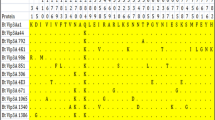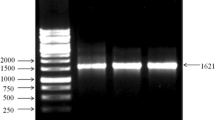Abstract
Characterization, direct sequencing of the PCR amplicon and phylogenetic relationship was done to discover a novel Vip protein genes of the Bt isolates, to improve the prospects for insect control, more Vip proteins should be sought out and researched to predict their insecticidal activity. Characterization was based on direct sequencing of PCR amplicon using primers specific to vip3A gene was presented here. 12 out of 18 isolates screened were positive for vip gene-specific primers. Homology search for the partial sequences using BLAST showed that 11 isolates had high similarity to vip3Aa gene and only one fragment with vip3Ae gene (25–100% at nucleotide and amino acid level). Phylogenetic analysis showed that the gene sequences were responsible for geographic separation for divergence within vip genes, consistent with the evaluation of distinct bacterial population. Despite the geographical distances, strains harbouring vip genes have originated from common ancestors may significantly contribute to control resistant insect pests. Some strains have evolved to be quite distinct and others remain as members of closely related groups. The reported method is a powerful tool to find novel Vip3A proteins from large-scale Bt strains which is effective in terms of time and cost. Further the Vip proteins produced by different strains of B. thuringiensis are unique in terms of the sequence divergence and hence may also differ in their insecticidal activities.


Similar content being viewed by others
References
Asokan R, Puttaswamy (2007) Isolation and characterization of Bacillus thuringiensis Berliner from soil, leaf, seed dust and insect cadaver. J Biol Control 21:83–90
Ben-Dov E, Wang Q, Zaritsky A, Manasherob R, Barak Z, Schneider B, Khamraev A, Baizhanov M et al (1999) Multiplex PCR screening to detect cry9 in Bacillus thuringiensis strains. Appl Environ Microbiol 65:3714–3716
Bernhard K, Meadows M, Butt J, Ellis DJ, Roberts GM, Pauli S, Burges HD (1997) Natural isolates of Bacillus thuringiensis: worldwide distribution, characterization and activity against insect pests. J Invertebr Pathol 70:59–68
Bravo A, Sabaria S, Lopez L, Ontiveros H, Abarca C, Oritz A, Oritz M, Lina L, Villalobos JF, Pena G, Valdez NEM, Sobero M, Quintero R (1998) Characterisation of cry genes in Mexican Bacillus thuringiensis strain collection. Appl Environ Microbiol 64:4965–4972
Ceron J, Ortíz A, Quintero R, Guereca L, Bravo A (1995) Specific PCR primers directed to identify cryI and cryIII genes within a Bacillus thuringiensis strain collection. Appl Environ Microbiol 61:3826–3831
Cheryl EB, Leon Cour T, Annemie B, Roslyn M, Van Jeroen R, Raymond JA (2008) Unusually high frequency of genes encoding vegetative insecticidal proteins in an Australian Bacillus thuringiensis collection. Curr Microbiol 57:195–199
Christner BC, Thompson EM, Thompson LG, Reave JN (2003) Bacterial recovery from ancient glacial ice. Environ Microbiol 5:433–436
Crickmore N, Zeigler DR, Feitelson J, Schnepef E, Van Rie J, Lereclus D, Baum J, Dean DH (1998) Revision of the nomenclature for the Bacillus thuringiensis pesticidal crystal proteins. Microbiol Mol Biol Rev 62:813–870
Donovan WP, Donovan JC, Engleman JT (2001) Gene knockout demonstrates that vip3A contributes to the pathogenesis of Bacillus thuringiensis towards Agrotis ipsilon and Spodoptera exigua. J Invertebr Pathol 78(1):45–51
Doss VA, Kumar A, Jayakumar R, Sekar S (2004) Cloning and expression other insecticidal protein (vip3V) gene of Bacillus thuringiensis in Escherichia coli. Protein Exp Purif 26:82–88
Espinasse S, Chaufaux J, Buisson CH, Perchat S, Gohar M, Bourguet D, Sanchis V (2003) Occurrence and linkage between secreted insecticidal toxins in natural isolates of Bacillus thuringiensis. Curr Microbiol 47:501–507
Estruch JJ, Carozzi NB, Desai N, Duck NB, Warren GW, Koziel M (1997) Transgenic plants: an emerging approach to pest control. Nat Biotechnol 15:137–141
Estruch JJ, Warren GW, Mullins MA, Nye GJ, Craig JA, Koziel MG (1996) Vip3A, a novel Bacillus thuringiensis vegetative insecticidal protein with a wide spectrum of activities against lepidopteran insects. PNAS 93:5389–5395
Fang J, Xu X, Wang P, Zhao JZ, Shelton AM, Cheng J, Feng MG, Shen Z (2007) Characterization of chimeric Bacillus thuringiensis Vip3 toxins. Appl Environ Microbiol 73:956–961
Federici BA (2005) Insecticidal bacteria: an overwhelming success for invertebrate pathology. J Invertebr Pathol 89:30–38
Hernandez-Rodrignez CS, Boets A, Van Rie J, Ferrie J (2009) Screening and identification of vip genes in Bacillus thuringiensis strains. J Appl Microbiol 107(1):219–225
Ichimatsu T, Mizuki E, Nishimura K, Akao T, Asitoh H, Higuchi K, Ohba M (1998) Occurrence of Bacillus thuringiensis in fresh waters of Japan. Curr Microbiol 40:217–220
Juarez-Perez VM, Ferrandis MD, Frutos R (1997) PCR-based approach for detection of novel Bacillus thuringiensis cry genes. Appl Environ Microbiol 63:2997–3002
Jung YC, Kim US, Bok HS, Park YH, Opte CJ, Chung SY (1998) Characterization of Bacillus thuringiensis mutants and natural isolates by molecular methods. Can J Microbiol 44:403–410
Kaelin P, Gadani F (2000) Occurrence of Bacillus thuringiensis of cured tobacco leaves. Curr Microbiol 40:205–209
Kalman S, Kichne KL, Cooper N, Reynose MS, Yamamoto T (1995) Enhanced production of insecticidal proteins in Bacillus thuringiensis strains carrying an additional crystal protein gene in their chromosomes. Appl Environ Microbiol 61:3063–3068
Kati H, Sezen K, Demirbag Z (2007) Characterization of a highly pathogenic Bacillus thuringiensis strain isolated from common Cockchafer, Melolontha melolontha. Folia Microbiol 52:146–152
Lee MK, Walters FS, Hart H, Palekar N, Chen JS (2003) The mode of action of Bacillus thuringiensis vegetative insecticidal crystal protein Vip3A differs from that of Cry1Ab delta endotoxin. Appl Environ Microbiol 69:4648–4657
Maeda M, Mizuki E, Nakamura Y, Hatano T, Ohba M (2000) Recovery of Bacillus thuringiensis from marine sediments of Japan. Curr Microbiol 40:418–422
Martínez C, Caballero P (2002) Content of cry genes and insecticidal toxicity of Bacillus thuringiensis strains from terrestrial and aquatic habitats. J Appl Microbiol 92:745–752
Rang C, Gill P, Neisner N, Van Rie J, Frutos R (2005) Novel Vip3-related protein from Bacillus thuringiensis. Appl Environ Microbiol 71:6276–6281
Ritu B, Monika D, Siva KP, Borra J, Ajin DM, Singh AK, Polumetla AK (2005) Isolation, characterization and expression of a novel vegetative insecticidal protein gene of Bacillus thuringiensis. FEMS Microbiol Lett 243:467–472
Song F, Zhang J, Gu A, Wu Y, Han L, He K, Chen Z, Yao J et al (2003) Identification of cry1I-type genes from Bacillus thuringiensis strains and characterization of a novel cry1I-type gene. Appl Environ Microbiol 69:5207–5211
Swiecicka I (2008) Natural occurrence of Bacillus thuringiensis and Bacillus cereus in eukaryotic organisms: a case of symbiosis. Biocontrol Sci Technol 18:221–239
Swiecicka I, Mahillon J (2005) The clonal structure of Bacillus thuringiensis isolates from north-east Poland does not correlate with their cry gene diversity. Environ Microbiol 7:34–39
Wu JY, Zhao FQ, Bai J, Deng G, Qin S, Bao QY (2007) Evidence for positive darwinian selection of vip gene in Bacillus thuringiensis. J Genet Genomics 34:649–660
Yu CG, Mullins MA, Warren GW, Koziel MG, Estruch JJ (1997) The Bacillus thuringiensis vegetative insecticidal protein (vip) 3A lyses midgut epithelial cells of susceptible insects. Appl Environ Microbiol 63:532–536
Acknowledgments
Infrastructure facility and encouragement by The Director, Indian Institute of Horticultural Research (IIHR) is duly acknowledged. The authors are grateful to ICAR, New Delhi for funding this study under Network project on Application of Microbes in Agriculture and Allied Sectors (AMAAS).
Author information
Authors and Affiliations
Corresponding authors
Electronic Supplementary Material
Below is the link to the electronic supplementary material.
Rights and permissions
About this article
Cite this article
Asokan, R., Swamy, H.M.M. & Arora, D.K. Screening, Diversity and Partial Sequence Comparison of Vegetative Insecticidal Protein (vip3A) Genes in the Local Isolates of Bacillus thuringiensis Berliner. Curr Microbiol 64, 365–370 (2012). https://doi.org/10.1007/s00284-011-0078-z
Received:
Accepted:
Published:
Issue Date:
DOI: https://doi.org/10.1007/s00284-011-0078-z




